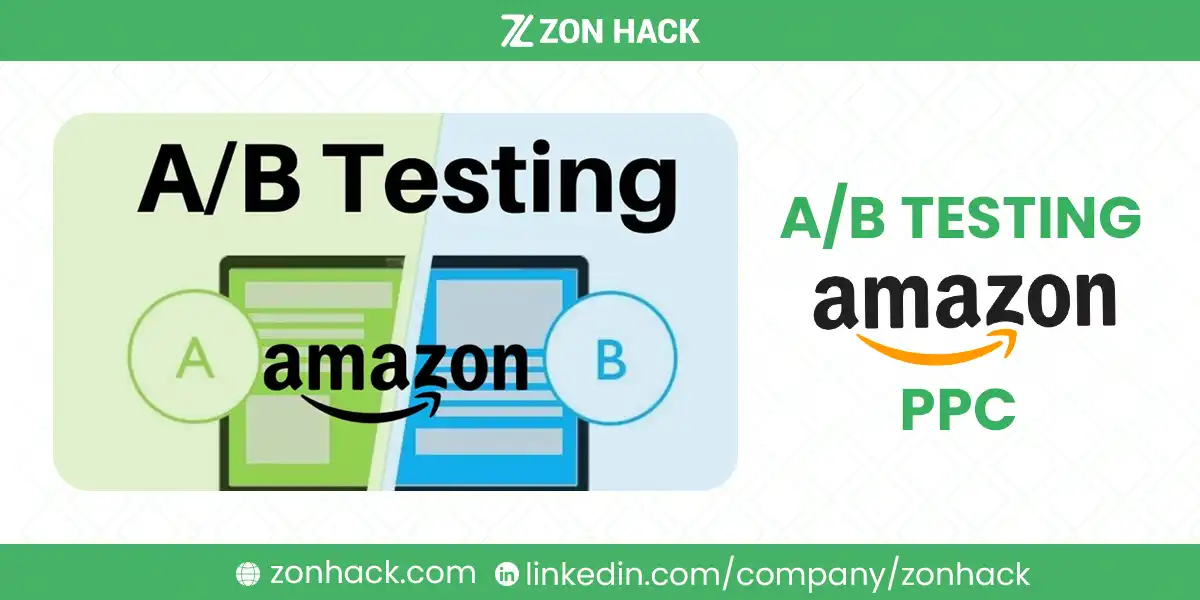A/B testing is an essential strategy for optimizing Amazon Pay-Per-Click (PPC) campaigns, allowing advertisers to experiment with different ad variations and pinpoint the best-performing elements. It is one of the most effective ways to boost your Amazon PPC performance, enhance your return on ad spend (ROAS), and fine-tune your marketing efforts.
This article discusses the importance of A/B testing for Amazon PPC campaigns, how to conduct these tests effectively, and how to interpret and act on the results to improve your campaigns.
Why A/B Testing is Essential for Amazon PPC?
Amazon PPC campaigns are competitive, and without A/B testing, you’re essentially shooting in the dark. A/B testing allows you to make data-driven decisions, providing clear insights into what works best for your audience, products, and budget. Here are some key reasons to incorporate A/B testing into your PPC strategy:
- Optimizes Campaign Performance: By testing variations, you can identify which ad formats, keywords, and targeting strategies yield the best results, improving your campaign’s ROI.
- Reduces Wasteful Spending: A/B testing helps you avoid wasting money on ineffective ad placements and allows you to reallocate your budget to the highest-performing ads.
- Improves Click-Through Rate (CTR): Testing different ad copy, images, or bidding strategies can directly affect your CTR, ensuring you’re only paying for clicks that are likely to convert.
- Adapts to Market Trends: Continuous testing helps you stay aligned with evolving trends, ensuring your ads remain relevant in a dynamic marketplace.
Types of A/B Tests for Amazon PPC
A/B testing for Amazon PPC can be implemented in various ways, depending on what you want to test. Here are the primary elements you should focus on:
1. Ad Copy Variations
Testing different versions of your ad copy is one of the most common A/B tests. You can try variations in the headline, description, and even the call-to-action (CTA). For example:
- Headline Test: Compare a straightforward headline versus a headline that includes a special offer or urgency.
- CTA Test: Test different CTAs like “Buy Now” versus “Shop Today” to see which resonates better with your audience.
2. Keywords and Match Types
Another essential area for A/B testing is your keywords. Testing broad, phrase, and exact match keywords can provide insights into which match type performs best for specific products. Additionally, you can test various long-tail versus short-tail keywords to see which drive more targeted traffic.
- Long-tail vs. Short-tail: Test a specific keyword versus a broader keyword to see which brings more qualified traffic.
- Exact Match vs. Broad Match: Test the precision of exact match versus the wider reach of broad match keywords.
3. Targeting and Audience Segmentation
Targeting plays a crucial role in Amazon PPC performance. Testing different targeting options such as product targeting, interest-based targeting, and competitor targeting allows you to optimize your ads for the right audience.
- Product Targeting: Test targeting products in the same category or those with similar attributes.
- Demographic or Behavioral Targeting: Test different audience segments to determine if your product appeals to specific groups (age, interests, purchase history).
4. Bidding Strategies
Bidding strategies significantly affect your ad’s visibility and overall performance. By adjusting the bidding strategy, you can determine the optimal bid for your target keywords.
- Manual Bidding: Test different bid amounts to find the sweet spot for each keyword.
- Automated Bidding: Experiment with Amazon’s automated bidding versus manual bidding to see which offers a better ROI.
5. Budget Allocation
Allocating your budget efficiently is key for maximizing your PPC campaign’s effectiveness. A/B testing different budget allocations between campaigns or targeting groups can reveal where the best return is coming from.
- Campaign Budget Split: Test a higher budget for one product versus another to see which one delivers a better conversion rate.
- Daily Spend Adjustments: Test variations in daily budget levels to ensure your ads are getting the right amount of exposure.
6. Ad Placements
Amazon offers multiple ad placements, including top-of-search and product detail pages. Testing different ad placements can help you understand where your ads are most likely to convert.
- Top-of-Search: Test whether ads placed at the top of search results yield more clicks and conversions.
- Product Detail Pages: Test whether showing ads on competitor product pages increases conversion rates.
How to Conduct A/B Testing for Amazon PPC
Here’s a step-by-step approach for implementing A/B tests for Amazon PPC campaigns:
Step 1: Identify the Objective
Before you begin your test, it’s crucial to identify your objective. Are you aiming to increase CTR, reduce ACOS (Advertising Cost of Sale), or optimize for conversions? Knowing your end goal will guide your test setup and help you measure success accurately.
Step 2: Set Up Your Tests
Choose one element to test at a time, such as ad copy, keywords, or targeting. Creating multiple variations allows you to compare how each one performs. Make sure the changes are clear and measurable, so you can easily determine what caused a performance shift.
- Control Group: The current version of your campaign acts as the control group.
- Test Group: The variation you want to test.
Step 3: Run the Test
Run the test for a sufficient duration to collect enough data for a statistically significant result. Avoid running the test for too short a time frame, as it may not give an accurate picture of performance.
Step 4: Monitor and Measure Performance
Track key metrics like CTR, conversion rate, and ACOS to gauge the performance of each test group. Tools like Amazon’s Campaign Manager or third-party platforms like Helium 10 or Jungle Scout can provide detailed insights into the effectiveness of your ads.
Step 5: Analyze the Results
Once the test period is complete, analyze the data. Look for statistically significant differences in performance metrics. The winning variation should align with your campaign objectives.
Step 6: Implement Insights and Repeat
Apply the successful changes to your campaigns, but continue testing other elements. A/B testing is an ongoing process that should be integrated into your PPC optimization routine to ensure long-term success.
Advanced A/B Testing Strategies
For those who are already familiar with A/B testing basics, advanced strategies can help unlock even greater performance improvements. These techniques allow you to experiment with higher levels of sophistication, making your tests more impactful and tailored to specific seasonal trends or business needs.
Seasonal Testing Calendar
Sellers who understand the cyclical nature of consumer behavior can strategically time their A/B tests to capitalize on periods of heightened interest. For example, during Q4, holiday shopping is a key focus, and A/B testing should zero in on boosting conversion rates with tailored offers or promotions. Here’s how advanced sellers approach each season:
| Season | Focus Area | Key Metrics |
| Q1 | Post-holiday retention | Repeat purchase rate, customer lifetime value |
| Q2 | Summer prep | CTR optimization, customer engagement |
| Q3 | Q4 preparation | Inventory alignment, seasonal messaging |
| Q4 | Holiday shopping | Conversion rate, ROAS |
By aligning your A/B testing efforts with these seasonal goals, you can ensure that your campaigns are not only effective but also responsive to the changing demands of consumers.
Progressive Testing Framework
Instead of relying solely on one-off tests, a progressive testing framework is about continuous, iterative improvement. Sellers employing this strategy follow a more granular approach, optimizing campaigns incrementally over time:
Baseline Establishment:
- Gather initial data and establish benchmarks for key metrics (e.g., CTR, conversion rates).
- Conduct a thorough analysis of competitors’ performance to identify potential opportunities.
- Review historical data to understand trends and prepare for upcoming market shifts.
Iterative Improvement:
- Focus on weekly performance reviews to monitor test results and identify patterns early.
- Conduct rapid, small-scale tests to quickly verify hypotheses without committing large budgets.
- Implement adjustments as you go based on real-time data, ensuring that each iteration leads to measurable improvement.
By following a progressive framework, you’re constantly refining your PPC campaigns, which leads to more sustainable, long-term growth rather than quick fixes.
Best Practices for Amazon PPC A/B Testing
To ensure that your A/B tests are delivering maximum value, it’s important to take a strategic, methodical approach. These tips and best practices will help you optimize your testing process and avoid common pitfalls.
Detailed Test Tracking
Tracking your tests is just as important as running them. Creating a detailed test log allows you to keep track of all the variables, outcomes, and adjustments, making it easier to spot patterns over time. Here’s a simple framework for tracking your A/B tests:
| Test Name | Start/End Dates | Variables Tested | Results | Actions Taken | Lessons Learned |
| “Kitchen Knife Image” | 01/10/2024 – 01/17/2024 | Main Image (Product vs. In-use) | CTR: +45%, ACoS: -22% | Increased focus on lifestyle images | Images showing usage generate higher engagement |
Test Logging Best Practices
- Log each test as a standalone project to analyze its individual impact.
- Track not just the direct metrics (CTR, conversion rates), but also the broader outcomes such as ACoS and overall sales.
- Review lessons learned after each test to refine your strategy for future tests.
Test Duration and Budgeting Tips
The right test duration and budget allocation are critical to ensure you gather enough data to make accurate decisions. Keep these factors in mind:
- Test Duration: For low-traffic campaigns, longer test durations (4-6 weeks) might be necessary, while high-traffic ads may reach statistically significant results in just 1-2 weeks.
- Budgeting: Start with a moderate daily budget and gradually scale if results are promising. Ensure that you are allocating enough funds per variant to achieve reliable data. A minimum budget of $50 per day per variant is recommended for meaningful results.
Ensuring Statistical Significance
A crucial component of A/B testing is ensuring that your results are statistically significant. Statistical significance means that the results are not just due to random chance, but that there is a high degree of confidence in the data. Use tools like an A/B test calculator to ensure your test reaches at least a 95% confidence level. This ensures that any changes in performance are truly attributable to the changes you made in the test, not random variations.
Summary
A/B testing is an indispensable tool for Amazon PPC campaigns, enabling advertisers to refine their strategies and maximize their return on investment. Whether you are testing ad copy, keywords, targeting, or bidding strategies, A/B testing helps you identify the winning formula for your ads. With careful planning and consistent testing, you can ensure your Amazon PPC campaigns are constantly improving and delivering the best possible results.




